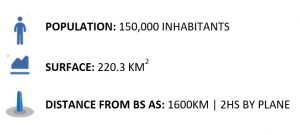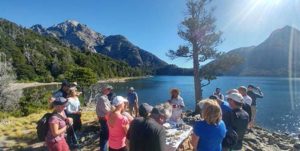San Carlos de Bariloche, known simply as Bariloche, is located 1600 km southwest from Buenos Aires, the entrance airport of Argentina. Bariloche: the city is surrounded by the magnificent Nahuel Huapi National Park, which also hosts the North Patagonia Andean Biosphere Reserve. Bariloche is considered the tourist capital of Patagonia. Bariloche is the most visited destination in Patagonia and one of the most visited destinations in Argentina. It receives around one million tourists annually, mainly in the winter season, among which the ones coming from European and South American countries stand out for their influx. Its infrastructure, landscape diversity and the wide variety of activities that can be carried out throughout the year in a unique natural environment make Bariloche the perfect destination for Business Tourism.
Its nature reserves, which include lakes, forests and mountains, and its outstanding ski centers are the main attraction of Bariloche. The city has been considered by some sources as the second ski destination in the world and the largest in South America. It also has the largest birds in the world.

Tourism is the main economic activity of the city. Due to its geographical characteristics, there are activities that take place during the summer months and other winter activities. The city is located in the center of the Nahuel Huapi National Park and is the gateway (by water) of the Los Arrayanes National Park that protects an estimated myrtle forest. A series of specially conditioned catamarans allow you to take walks and lake excursions on Lake Nahuel Huapi.

It annually receives national and international tourism, which delights in the multiple activities offered by this city on the edge of Lake Nahuel Huapi. The most important ski center in Argentina is Cerro Catedral, located 20 km from San Carlos de Bariloche. Another ski center is the Otto hill where Nordic skiing is practiced, also known as cross-country or cross-country skiing.
According to a study carried out by the Faculty of Human Sciences of the National University of the Center and CONICET, Bariloche is the second city with the best quality of life in Argentina to live.
Bariloche is also one of the most important scientific and technological centers in the Americas, where the Bariloche Atomic Research Center, belonging to the National Atomic Energy Commission, and the Balseiro Institute, of the National University of Cuyo, are located the career of Physics, Mechanical and Nuclear Engineering and Telecommunications Engineering. The city is the headquarters of INVAP, a high-tech Argentine company that designs and builds nuclear reactors, radars and satellites, among others.
In 2014, residents of the city made the largest chocolate bar in the world with 130 meters long and 800 kg in weight. In addition, the city has the record for the largest Easter egg in the world made with 8,000 kg of chocolate in 2015. By 2016, the city once again surpasses itself and produces the largest chocolate bar in the world with 150.5 meters and for the year 2017, the chocolate bar was 200 meters using 1500 kilos of chocolate and 400 kilos of dried fruit.

Bariloche is nationally and internationally connected. Bariloche’s airport just a two hour flight away from the City of Buenos Aires and has regular routes to and from Buenos Aires, Rosario, Cordoba, Mendoza and El Calafate, among others. A large number of charter flights also arrive from Brazil and Chile. What is more, modern transport units from different Argentine cities and neighboring countries arrive by land to the bus terminal, which makes Bariloche a distribution hub for the lakes region and Chile.
ACCOMODATIONS
With over 700 hotel establishments of different categories and wide-ranging characteristics, the city of Bariloche has approximately 29,000 bed places, offering its visitors world-class accommodations, which stands out for the hospitality and warmth of its hosts.
As Bariloche is an international tourist center, it receives all kinds of visitors. Some look for 5 star hotels and, towards the other extreme is the backpacking tourism that is looking for low cost hostels. Also, May is considered low season and lodging prices are cheaper. Depending on the above ranking, an accommodation price can vary between 20 to 150 EUR per night, while the average price for a midrange hotel is about 60 EUR/per night. In this sense, both the lecturers and the students will be able to find accommodation for their needs. Interestingly, there are a lot of apart hotels and cabins located a few kilometers from the downtown, which suits an ideal environment for the participants coming with their families.
Many of the above listed accommodation facilities are located in the city downtown or only few kilometers from it. Public transport covers even the most remote city parts, so the conference site can be reached in a reasonable time even in unlikely case of a distant accommodation.

GASTRONOMY
The culinary establishments offer international and Patagonian delights, prepared by renowned chefs. The traditional Patagonian lamb, “curanto”, trout and smoked food are some of the most outstanding dishes, along with the elaboration of craft beer and the legendary chocolates, recognized throughout the world foquality and the excellent raw material.